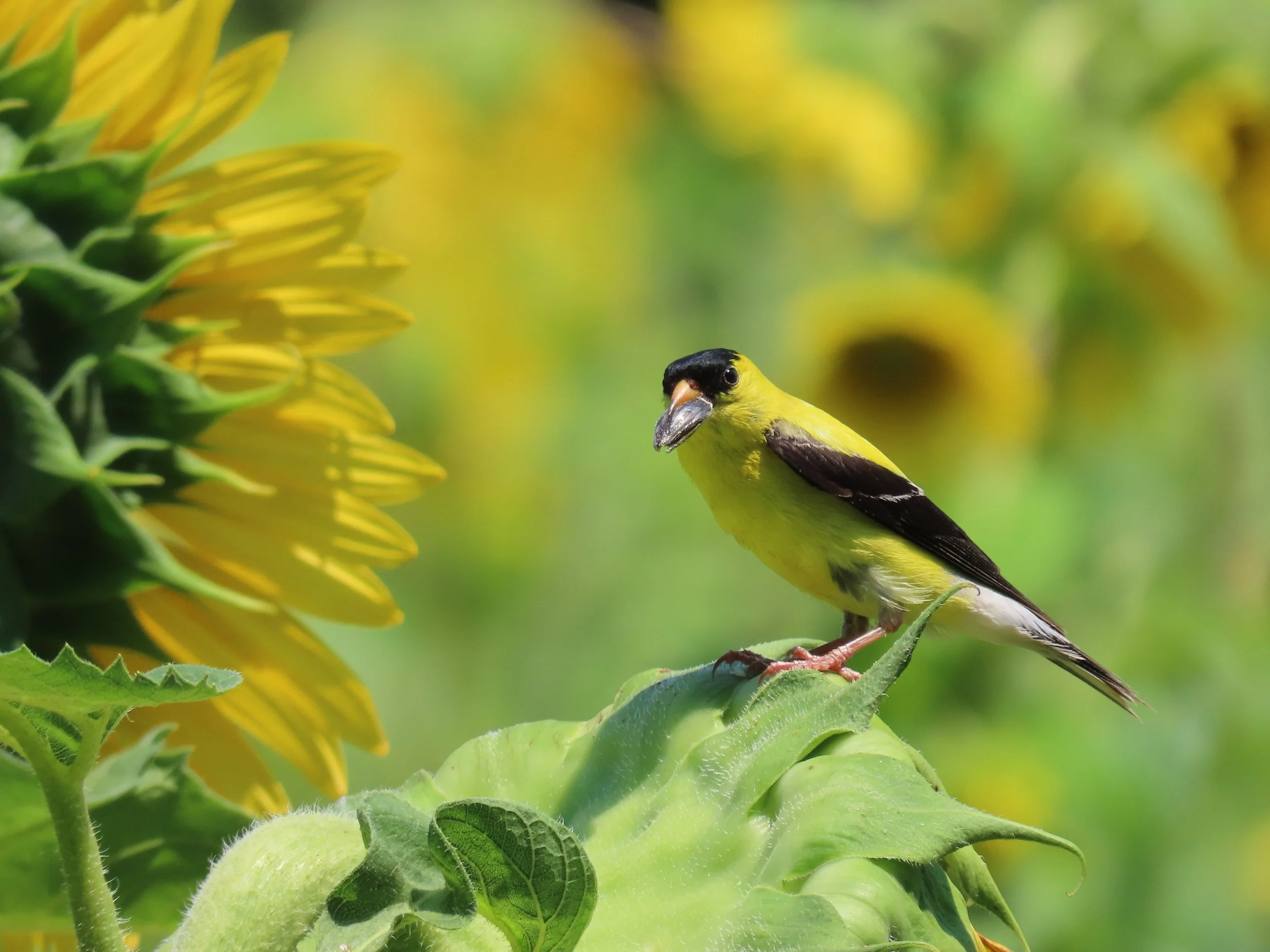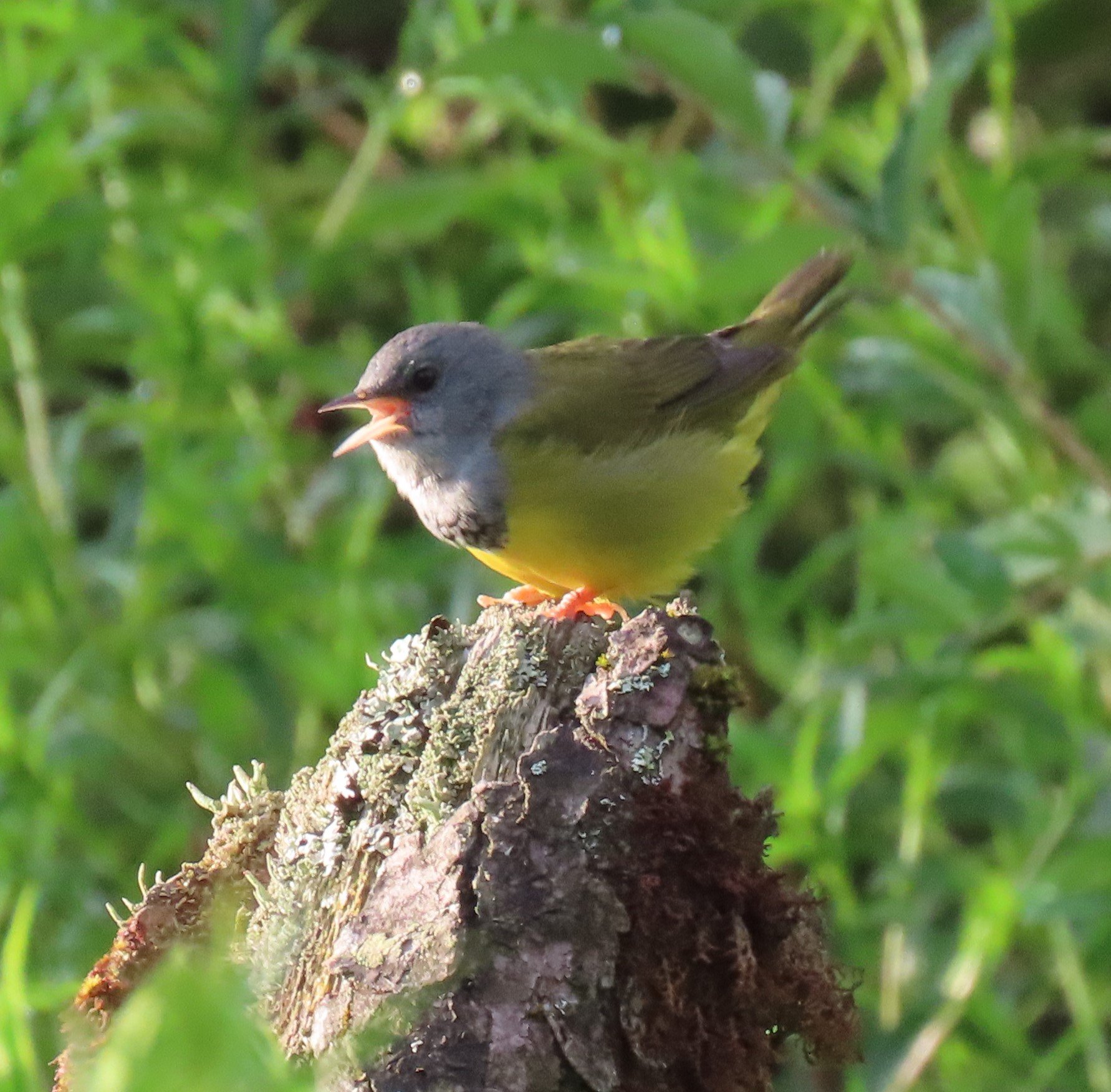Photo: American Goldfinch on sunflowers, Sycamore Landing, MD, Libby Lyons
Libby Lyons
As 2021 began, I was feeling listless – in a general sense and in the bird-list sense. So, I challenged myself to see 100 bird species each month, a “century” challenge, because I wanted to get out of the house and be more active, see more birding friends, and become more purposeful in my birding.
I can now report success!! From my first bird, the Painted Bunting on the C&O Canal (MD), to my last, an Audubon’s Oriole (TX), I saw 400 species in 2021– and at least 100 per month!! But I was rewarded with so much more than just a count of birds – here’s what I learned:
For me it’s as much about the people as the birds! I loved meeting and befriending so many folks with the same love of birds and nature. I went with them on trips far and near including the ASNV Birdathon and many Northern Virginia Bird Club trips. And I found I still get immense joy in sharing my passion – even with total strangers, e.g., showing my Painted Bunting photo to passersby wondering what all the fuss was about, and pointing out a perfectly camouflaged Wilson’s Snipe at Huntley Meadows and being called a “snipe whisperer.”
Piping Plover chick, Moonstone Beach, Trustom Pond NWR, Rhode Island, Libby Lyons
Birdwatch wherever you go! The pandemic kept me stateside, so I redoubled my efforts to bird more while visiting family. In a Rhode Island wildlife area on a balmy, buggy evening in May I was transfixed by the plaintive call of an Eastern Whip-poor-will, and then just down the road, by the dueling calls of two Chuck-will’s-widows. On my next trip, I delighted in a handful of little brown and white fluffballs, juvenile Piping Plovers, at Moonstone Beach (RI). When we retreated with our grown children to the cool of the West Virginia mountains in early August, I twice trekked off to Cranberry Glades bog, where I was rewarded with 9 species of warblers and 4 species of vireos so easily seen on their breeding grounds! In Olympic National Park in late August, it was a treat to join my brother as he led a boat tour of Lake Quinault and to revel in our shared love of natural history. From Washington I drove through smoky Oregon to stay with family friends and compiled a bird list for their yard among the Northern California redwoods, then headed to Point Reyes Bird Observatory, a birdwatcher’s mecca, which I had not visited in four decades. It is easy to forget how large and variable our country’s habitat is – there was almost no overlap between the West Coast birds I saw and those I had seen back East!
Mourning Warbler, Cranberry Glades Botanical Area, WV, Libby Lyons
Birdwatch all year! Another pleasant surprise was summer birding. I do not handle Virginia’s heat and humidity well, so had birded infrequently from mid-June to late August. I had rarely seen or heard fledglings, with their stubby tails, often murky plumage, and muddled songs! The summer foliage was also a pleasure – swaths of sunflowers in full bloom, replete with American Goldfinches and Indigo Buntings at Sycamore Landing (MD). And the wetlands at Huntley Meadows was transformed by the huge white flowers of the native hibiscus called Swamp Rose-mallow.
Photo: American Goldfinch on sunflowers, Sycamore Landing, MD, Libby Lyons
Even new birders can surprise you! Near November‘s end, I was still far short of my target. I was in a migration void – the passerines had flown south and the waterfowl had yet to arrive. I headed to the coast with my adult son, who is not a birder. He is a serious fisherman – observant, patient, and nature-loving – perfect skills for birdwatching. He not only spied a Black Skimmer (“That bird can’t keep its head up!”) at India River Inlet (DE), but he also spotted a sandbar harboring American Oystercatchers and Brants. As we chatted about why we loved our respective hobbies – he framed birdwatching in a way novel to me, perhaps due to his years studying economics. One reason birders are so friendly, he noted, is that sharing information about a target species doesn’t deplete the resource the way it might for fishing. Not only that, sharing makes you feel good, it helps the other person, and it increases the chances that they might share information back.
LeConte’s Sparrow, Sully Woodlands Park, VA, Libby Lyons
Be opportunistic and persistent! I took advantage of “lost” birds last year. There seemed so many – was it because so many of us were out birding, or just because the birds were roving farther afield? Certainly, the Green-tailed Towhee in Sky Meadows State Park (VA) and the Kirtland’s Warbler in Baltimore (MD) were far from their usual stomping grounds (West Coast and Michigan, respectively). And I was persistent – it took two attempts each to see that Green-tailed Towhee and the skulking, well-camouflaged LeConte’s Sparrow at Sully Woodlands, and three trips to see my nemesis bird, another skulker, the Connecticut Warbler, in Rock Creek Park (DC). Alas, it is valuable to temper persistence with common sense; it was a lot easier to spot a Ross’s Goose (white, slightly smaller than a Snow Goose) among a few Canada Geese at Mount Trashmore Park (VA) than among 4,000 white Snow Geese on a Delmarva field!
What next? I am not sure whether I will continue with the challenge in 2022. I hope to travel farther afield when COVID allows. But as the climate crisis looms, I am also trying to birdwatch with a smaller environmental footprint. I think this will mean more carpooling, not making long trips just to get the last few birds for the month, and exploring new places to birdwatch close to home. I don’t think I will ever tire of the Sandhill Cranes at Algonkian, the warblers at Monticello Park, the woodcock at Huntley Meadows, nor the rafts of winter waterfowl off Mason’s Neck. Join me!





